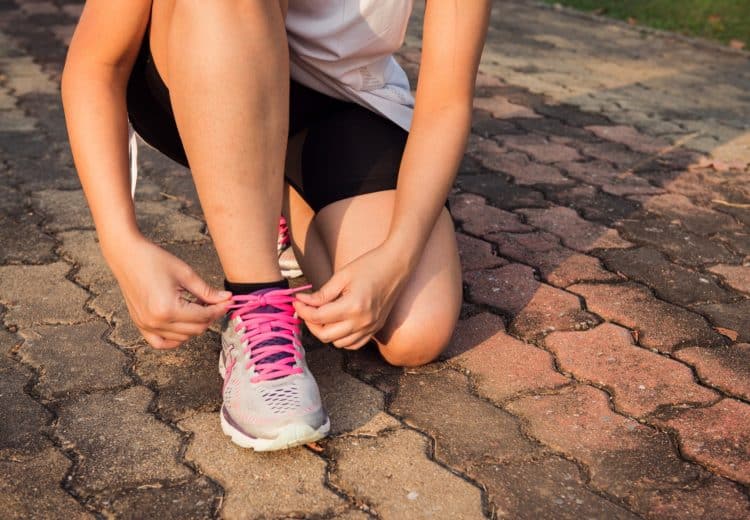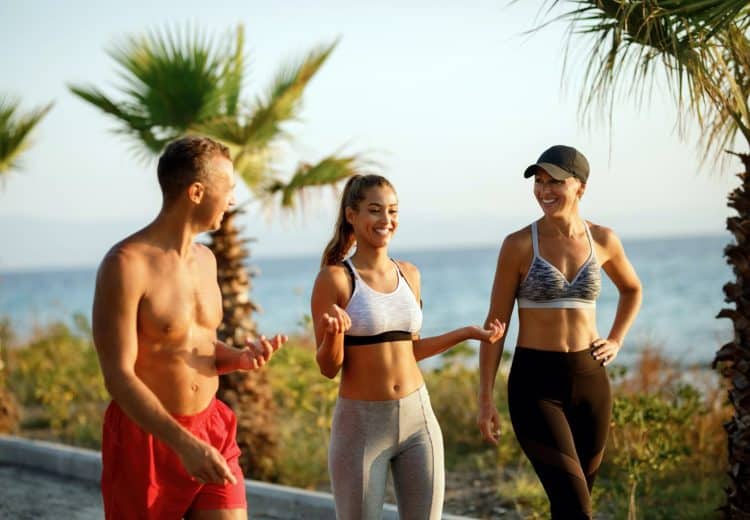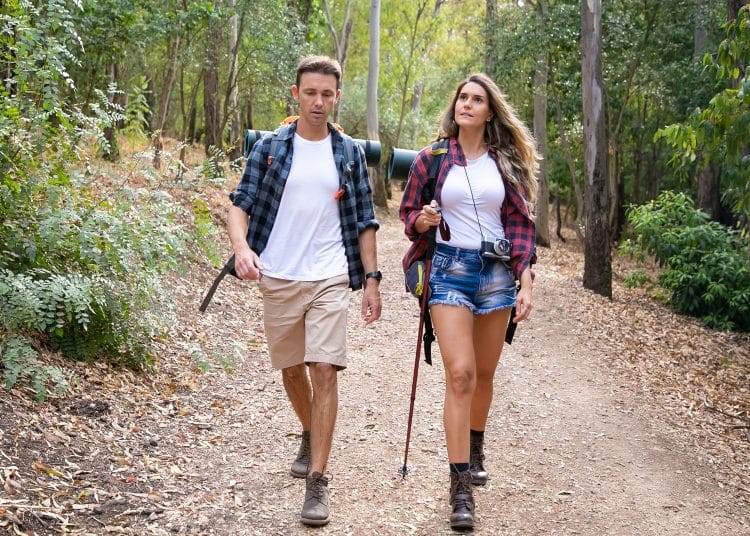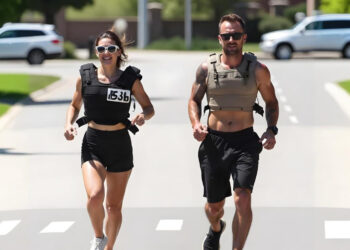Experts agree that to get fit, lose weight, and build muscle, most people need to accumulate three to five hours of structured exercise per week. The actual contents of your workouts will depend on your training goal but should include resistance training, cardio, core work, and mobility training in varying combinations.
And while the three to five hours per week guideline is a good target, it’s entirely possible that despite your workouts, you are still too inactive to reach your fitness and body composition goals.
That’s because even if you spend five hours in the gym per week, there are 163 hours remaining during which you could be sedentary.
Suppose you have an office job, play no recreational sports, or have passive hobbies. In that case, your workouts could be your only source of physical activity, and suddenly, five hours of exercise per week doesn’t look so impressive.
The good news is there is an easy way to increase your physical activity levels that won’t tire you out, fits easily into even the busiest schedule, and doesn’t cost any money.
We’re talking about walking!
Level Up Your Fitness: Join our 💪 strong community in Fitness Volt Newsletter. Get daily inspiration, expert-backed workouts, nutrition tips, the latest in strength sports, and the support you need to reach your goals. Subscribe for free!
In this article, we reveal the steps (pun intended) you need to take to start walking your way to fitness and fat loss.
The Advantages and Benefits of Walking
Walking is arguably one of the best forms of exercise around. However, because it’s simple, accessible, easy, and not very meme or Instagram-worthy, it’s easy to overlook in favor of things like HIIT, circuit training, and other “sexier” workouts.
That’s a shame because, in terms of bang for your buck, walking is one of the most beneficial physical activities and something almost everyone needs to do more.
The advantages and benefits of regular walking include:
Accessibility
You can walk almost anywhere and anytime. You don’t need any special equipment or athletic ability, and there are no elaborate skills or advanced techniques to learn. As such, walking is the ultimate excuse-free workout. All you need to do is get up off your butt, head out the door, and start putting one foot in front of the other. There is no need to wait; you can go for a walk today!
Scalability
It doesn’t matter how fit (or unfit) you are; walking can help you reach your fitness and fat loss goals. Walk faster and further for a more intense workout, or do just a few minutes at a slower pace if you are a beginner. There are plenty of ways to make walking more challenging, so there is very little chance you’ll ever outgrow this excellent form of exercise or that you’ll be unable to start.
Low injury risk
When you jog or run, your feet hit the floor with a force equal to about eight times your body weight. That puts a lot of stress on your joints and could easily cause injuries. Providing you wear supportive shoes and don’t do too much too soon, the chances of hurting yourself by walking are very low. In fact, walking-related injuries are almost unheard of!
Non-fatiguing
Unlike more intense workouts, walking doesn’t take a lot out of you, so it won’t leave you feeling exhausted. A quick drink to rehydrate and a few minutes sitting down should be all you need to recover from a walk.
Because of this, you should have no problem walking every day. Daily walks will significantly increase your daily energy expenditure and physical activity levels, helping you to lose weight and get fit faster.
Sociable
While your heart and breathing rate will increase when you walk, you should still remain firmly in the aerobic training zone. As such, you should have no problem maintaining a conversation as you walk.
Make the most of this, and help the miles pass faster by walking with a friend or partner and enjoying a good chat.
Walking with a friend or partner will also raise your motivation levels, especially if you agree to meet on a particular day or at a certain time. This kind of scheduled commitment means you are much less likely to skip your walking workout.
Time-saving
In some cases, walking will save you time compared to driving or taking public transport. With no traffic to contend with, and no need to spend time looking for parking spaces, you will probably find you can walk short distances faster than if you used mechanized transport. Walking will also save you money and is far better for the environment. Commit to walking journeys of less than a mile to fit more walking into your day.
Boost recovery
Walking is one of the best ways to ward off and treat delayed post-workout muscle soreness, or DOMS for short. Walking increases blood flow and floods your muscles with oxygenated blood, which helps “wash away” the metabolic waste products of intense exercise, including lactic acid.
Even if you feel tired after your previous workout, walking will breathe new life into your muscles, so you recover faster and feel less fatigued. You may even feel ready to work out sooner.
Improved creativity and productivity
We all have days where we find it to put our thoughts in order or come up with new ideas. Unfortunately, brain fog is often worse when you are under pressure to be productive.
Instead of staring blankly at your computer screen, get up and head out for a walk.
You will probably find that your brain responds well to the break and your thoughts start to flow more easily. You may even come up with unique solutions to whatever you’re working on. So, the next time you feel “mentally constipated,” go for a walk and let nature take its course!
Toned, stronger legs
Walking thousands of steps per day will tone and strengthen your legs and increase local muscular endurance. Going for a daily walk probably won’t give you bodybuilder-sized legs. Still, you should notice your muscles getting firmer and feeling less tired.
Uphill walking and uneven terrains are even better for improving the condition of your leg muscles.
Good for your cardiovascular health
It’s all well and good having bulging biceps and a six-pack, but the muscle that really matters is your heart. Walking provides a good workout for your entire cardiovascular system, which is the collective name for your heart, lungs, and blood vessels.
Good cardiovascular fitness is intrinsically linked to better cardiovascular health and can lower your risk of:
- Coronary heart disease (CHD)
- Chronic obstructive pulmonary disease (COPD)
- Heart attack
- Stroke
- High blood pressure
- High cholesterol
Good for your general health
Walking is “big medicine” and can counteract many of the negative effects of an otherwise sedentary lifestyle. The general health benefits of regular walking include:
- Reduced risk of type II diabetes
- Increased bone mass
- Stronger, more stable joints
- Better balance
- Improved cognitive function
- Stronger leg muscles
- Less stress and anxiety
- Raise good cholesterol and lower bad cholesterol
- Lower triglycerides
- Weight loss and fat burning…
Walking for Weight Loss and Fat Burning
So, it’s pretty clear that walking is good for you, but how can it help you lose weight? After all, walking probably won’t make you feel out of breath, won’t leave you sweaty, and may even seem too easy to be effective.
And while it’s true that walking doesn’t burn lots of calories per hour, you can do a lot of walking every day. All those steps will add up to a decent amount of energy expenditure.
For example, let’s say you walk about 10,000 steps per day and doing so burns about 300 calories. 300 calories is not a lot of energy, but if you do that every day for a month, your walking will equal 6000 calories or about 1.7 pounds of fat. Do that every day for a year, and walking could help you lose as much as 20 pounds!
Of course, your results also depend on your diet and creating a calorie deficit. But, adding daily walks to your 3 to 5 times per week workout schedule should mean you can lose fat far faster than if you were more sedentary.
The key to walking for weight loss and fat burning is to do it every day. You can do one long walk or several short walks as preferred. Set a minimum cumulative target, e.g., 30 minutes or 10,000 steps, and do your utmost to hit it every day.
Walking for Fitness
Contrary to popular opinion, you don’t have to do high-intensity workouts to build fitness. In fact, low-intensity cardio can improve your fitness too.
When you do low-intensity cardio, your muscles demand more oxygen, so your heart and breathing rate increase to supply more of what your body needs.
Repeated workouts strengthen your heart, so it can pump more blood per beat. Similarly, your lungs become more efficient and can deliver more oxygen to and remove more carbon dioxide from your blood. Blood supply to your muscles also improves as capillary density increases.
However, to get fit by walking, you will need to pick up the pace somewhat, so your heart rate increases, and you are slightly out of breath. While slower walking offers many health benefits and can help you lose weight, you need to walk quite briskly if you want to improve your fitness. However, your workouts will still be relatively low-intensity compared to many other types of exercise.
To get fit by walking, walk briskly enough that your heart rate increases noticeably, and you are slightly out of breath. However, you should still be able to maintain a conversation but should need to take breaths between sentences. This should equate to about 60% of your maximum heart rate.
How to Get the Most from Walking
The great thing about walking is how simple it is. Pull on your shoes, head out the door, and get going! It really doesn’t require any more thought or preparation than that. However, there are a few “tricks of the trade” that could make walking even more effective.
See how many of these walking pro tips you can use to make your workouts more productive or enjoyable.
Wear supportive, cushioned shoes
In theory, at least, you can wear any kind of shoe for walking. However, because you’ll hopefully be walking further and more often than the average person, you’ll probably be more comfortable if you wear appropriate footwear.
Good walking shoes are cushioned, supportive, flexible, and breathable, and not too heavy. Above all, they should be comfortable and not pinch or rub. Sneakers are fine for pavement walking, but proper hiking shoes or boots are best if you plan on hitting the trails.
Make sure you monitor your shoes for wear and tear and replace them if they start to lose their support or cushioning. Most shoes are good for 500 miles or so. After that, they begin to break down and won’t be as supportive or shock-absorbing as they were when you bought them.

Walk with purpose!
There should be a noticeable difference in walking technique and speed from wandering aimlessly around the mall and stepping out for fitness or fat loss. If you are walking for exercise, you should stride out, walk briskly, and use your arms for added momentum.
That doesn’t mean you should feel uncomfortable or that you are racing, but you should look and feel like you are exercising rather than strolling.
Walk with good posture
Posture is the alignment of your joints, and it can be good or bad. Spending a lot of time sitting at a desk or driving means many people have very poor posture and are habitual slumpers and slouchers.
Don’t risk making your posture worse by walking with a slouch. Instead, stand tall, pull your shoulders down and back, and look straight ahead rather than down at your feet. Imagine your head is full of lighter-than-air helium and that it’s “floating” at the end of your neck.
While you’ll probably fall back into a slouch if you stop thinking about your posture, good posture will become more habitual with practice.
Monitor your walking performance
While any walking is good walking, you’ll get more from your workouts if you monitor your performance. Ways to do this include using a stopwatch to time your walks, using a GPS (global positioning system) to measure distance, or using a step counter.
However you monitor your walking performance, you can use this information to control the length of your workouts. For example, if you start out by walking 5,000 steps per day, you can increase that by 500 each week until you hit 10,000 steps per day. Gradual increases in walking volume will ensure your fitness levels continue improving.
Dress for the weather
We want you to walk every day so you can enjoy all the benefits of this effective and accessible form of exercise. That means going out in all but the worst weather. Dress for the elements to ensure your walks are comfortable and safe.
That means a sun hat, sunglasses, and high SPF sunscreen during the summer, and a waterproof coat and gloves in the winter. Also, if walking at night, make sure you’ll be seen by wearing light-colored or reflective clothing and carrying a torch.
Dress in layers
It doesn’t matter what you wear for your walks so long as you are comfortable. That said, it’s quite normal to get warmer after a few minutes, so you should dress in layers so you can easily control your temperature and avoid overheating.
A hoodie with a zip front is perfect, as you can start with your hood up and your top zipped, then drop the hood and lower the zip as your temperature rises.
Set a walking schedule
Like any workout, you’ll get more from walking if you do it regularly, and the best way to do that is to set a walking schedule.
For example, you could commit to getting up a little earlier and walking for 30-60 minutes before breakfast each morning. Alternatively, you could walk for 15 minutes before work, 30 minutes at lunchtime, and 15 minutes after dinner.
It doesn’t really matter when you walk, so long as you accumulate enough steps each day, especially when your goal is fat loss and weight control.
Walking at the same time each day helps establish a habit, and when it comes to successful fitness and weight loss, habits make regular exercise much easier to sustain.
Set a daily walking goal
You are much more likely to stick to your walking schedule if you have a daily distance or time goal. Most people find it easiest to count steps for this purpose. Your step goal depends on your fitness and health, but good examples include:
- Beginner: 8,000 to 10,000 steps per day.
- Intermediate: 10,000 to 15,000 steps per day.
- Advanced: 15,000 to 20,000 steps per day.
Of course, you don’t have to do the same number of steps each day and may have different goals for different days, depending on what else you have planned. For example, on a non-gym day, you might do 15,000 steps, but only 10,000 steps on the days you do your strength training workouts.
Related: How Many Miles is 20,000 Steps?
Level Up Your Fitness: Join our 💪 strong community in Fitness Volt Newsletter. Get daily inspiration, expert-backed workouts, nutrition tips, the latest in strength sports, and the support you need to reach your goals. Subscribe for free!
Monitor your heart rate
If you are walking for fitness, you must get your heart rate to 60% or above your age-adjusted maximum, usually calculated by 220 minus your age. Less intense workouts aren’t as effective for improving your fitness. Use a heart rate monitor to ensure your heart rate is high enough to get the results you want.
Your heart rate is less important if you are walking for weight loss, but it’s worth noting that the faster you walk and the higher your heart rate, the more calories you’ll burn per minute.
For convenience, you can buy a fitness tracker watch that counts steps, has a GPS to measure distance, and displays your heart rate via a wrist sensor.
Vary the terrain, and head for the hills!
Any walking is good walking, but you’ll probably get better results if you vary the terrain and also include some hills in your workouts. Walking uphill increases the demand on your legs, heart, and lungs, increasing the fitness and energy cost of your workouts.
Walking on uneven surfaces, such as wooded trails, increases deep stabilizer muscle activation and also improves neuromuscular functions, such as proprioception, balance, and agility.
In contrast, doing all your walking on flat pavements or on a treadmill could make your workouts a little less effective and potentially less enjoyable.
Unplug from electronic devices
If possible, use your walks as an opportunity to enjoy some quality time away from social media and other electronic distractions. By all means, carry your phone, but put it on silent so you can walk without being disturbed. Resist the temptation to check your phone every few minutes and focus all your attention on walking mindfully.
Time away from electronic devices is good for your mental health and can help lower stress levels. No one is so important that they need to be connected 24/7.
Listen to motivating music or podcasts
At the risk of contradicting the previous point, you may find it motivating to listen to music or podcasts during your walks. This can be especially helpful during longer walks or when you follow the same route over and over.
However, make sure you set your phone to “do not disturb” so you can listen without being interrupted by calls or push notifications.
Wear a weighted vest or backpack for a more intense walking workout
Like any exercise, the more you do it, the less challenging walking will become. You can offset this by doing more, e.g., progressing from 10,000 to 12,000 to 15,000 steps a day. However, at some point, you’ll reach a ceiling of how many steps you can do, and more will be impractical.
Another way to progress your walking workouts is to wear a weighted vest or a backpack.
Carrying more weight forces your muscles to work harder. In turn, they’ll demand more blood and oxygen, increasing your heart and breathing rate. All this extra work will increase your calorie expenditure.
So, if your walking workouts are becoming too easy, a weighted backpack or weight vest could be the solution. Start with about 10% of your body weight and progress gradually from there.
You may also find that you don’t have (or want!) to walk so far to get a good workout when you’re carrying some extra weight.
Related: Steps to Miles Calculator
Hydrate
Depending on where you live, the temperature and weather, and how hard or fast you walk, you may sweat a lot during your workout. Make sure you drink plenty of water before you set off, and if you are planning on walking for more than 30 minutes, consider carrying a water bottle so you can drink and stay hydrated as you walk.
That said, if you are enjoying a leisurely walk and aren’t going to sweat much, you won’t need to carry water. Doing so could just be an unnecessary annoyance.
Try some walking interval training
When it comes to interval training, most people tend to think of alternating periods of fast running or sprinting with walking. However, you can get a great workout even if you never break into a run with walking interval training.
With this method, simply speed up until you are walking as fast as possible but not quite jogging. This is a very inefficient form of exercise, which means it’s far more demanding than running at the same pace. It’ll probably feel a little awkward, but that’s what makes this such a good workout!
Continue for 1-3 minutes, then slow down to a more comfortable speed. Continue for 1-2 minutes to catch your breath, and then repeat. Do as many sets as you wish.
Break up your walk with bodyweight or resistance band exercises
There is nothing to say that walking is a standalone workout or that you can’t combine it with other forms of training. In fact, walking is incredibly flexible and versatile, and you can incorporate other types of exercise into your walking workouts.
For example:
- At a park, do a set of calisthenics like push-ups or squats each time you pass a bench.
- Starting at an outdoor pull-up bar, do a set of pull-ups or chin-ups, walk away for two minutes, walk back again, and do another set of pull-ups/chin-ups.
- Carry a resistance band in your pocket and do a set of biceps curls or overhead presses every 3-5 minutes.
- Do a set of walking lunges every 1,000 steps.
You are limited only by your imagination! See what you can add to your walking workouts to make them more varied and challenging.
Diet Tips for Your Walking Weight Loss Journey
Even 10,000 steps of walking won’t help you lose weight if you overeat. However, if weight loss and fat burning are your goals, you need to pay as much attention to your diet as you do your workout and walking plan.

It’s beyond the scope of this article to tell you how to eat to lose weight – it’s a BIG subject! But here are some tips to get you started.
For more information on eating for health and weight loss, please check out this detailed guide.
- Eat fruits and/or vegetables at every meal.
- Consume protein at every meal.
- Cut down or eliminate completely sugary foods like candy and soda.
- Prepare as much of your own food as possible – eat fewer takeouts and processed meals.
- Drink plenty of water.
- Eat mindfully and slowly, paying close attention to how full you feel.
- Eat until you are no longer hungry, not until you are full. (There is a BIG difference!)
- Don’t let cheat meals ruin your weight loss efforts. Instead, keep them small and infrequent. Do not let a cheat meal turn into a weekend of binging.
- Don’t try any crash or fad diets. Instead, eat sensibly and follow a healthy, sustainable eating plan.
- Feel free to skip a meal or snack if you don’t feel hungry.
- Don’t drink your calories. Soda, fruit juice, coffee drinks, and smoothies contain a lot of calories but don’t fill you up.
- Cravings are usually psychological and not physical. Distract yourself by doing anything but thinking about food, and they’ll probably vanish all by themselves.
- Keep healthy, low-calorie food on hand in case hunger strikes. It’ll save you from grabbing a candy bar or another unhealthy, fattening snack.
- Plan and prep your meals in advance. Knowing what you are going to eat beforehand makes it easier to stick to your diet. Having no plan means you are more likely to grab something quick but unhealthy.
Like walking every day, healthy eating can become a habit. Don’t try and change your diet all in one go, as that’ll make it almost impossible to stick to. Instead, change a little at a time until, after a few weeks, you have learned to eat more healthily without overloading your willpower.
Walking for Fitness and Fat Loss FAQs
Do you have questions about walking for fitness or fat loss? No worries, we’ve got the answers!
Should I count steps, miles, or time?
It doesn’t really matter which you count as long as you use some way to measure how far you walk each day and you use the same method consistently.
If you’ve got a watch or phone app that counts steps, that’s a very good option. But, if you have a GPS, you can measure the distance in miles or kilometers instead. Or, you could just time your walks in hours, minutes, and seconds.
Related: Walking Steps to Miles Calculator
However you measure your walks, start easy and increase gradually over the coming weeks and months. Build the habit with easy workouts and make things more challenging once you’ve set that habit in stone.
What is the best time to go for a walk?
The best time to go for a walk is the time that fits best into your schedule. For some people, that’ll be early in the morning before breakfast. Others may find it easier to go for a walk at night. Walking at lunchtime may be more convenient or even spreading your walking throughout your day.
Experiment with different times to see which you prefer. If possible, set a fixed time to make going for a walk a habit.
Walking outside vs. treadmill – which is better?
Walking on a treadmill is okay when the weather is bad or you live somewhere where walking outdoors is dangerous. However, the treadmill does some work for you, and you won’t be out in the fresh air, so it’s not as good for you as walking outdoors.
If you can, choose outdoor walking as there are more benefits to being outside. There is more to see, there are natural undulations and terrain changes to cope with, and it’ll give you a chance to enjoy some fresh air and sunshine, all of which add to the walking experience.
How much weight can I lose by walking for one hour daily?
Assuming you burn about 300 calories per hour, walk every day, and your walks put you into a caloric deficit, you could lose as much as 20 pounds in a year just by walking. Doing other forms of exercise and creating a bigger caloric deficit will produce even better results.
Walking vs. aerobics – which is better?
Walking and aerobics both burn calories. An hour of aerobics burns more calories than walking because it’s more intense. That said, you will probably only be able to do 3-4 aerobics classes per week.
In contrast, walking burns fewer calories per hour, but you can do it more often. As such, it may lead to a more significant weekly caloric expenditure and more weight loss.
In terms of fitness, aerobics classes tend to be more intense than walking workouts unless you do higher-speed walking intervals. Both have the potential to make you fitter, and the best one depends on how hard you’re prepared to work.
Ultimately, the best one for you is the one you enjoy the most and can do regularly.
Walking vs. running – which is the best way to lose weight fast?
Running burns more calories than walking, so it should lead to faster weight loss. However, running every day is often impractical, and too much running can lead to injuries. In contrast, walking burns fewer calories, but you can do it daily and for longer, so it has the potential to be better for weight loss.
Why not try walking every day and running every other day? That way, you can enjoy all the benefits of daily walking while ramping up fat loss with a few running workouts.
Is walking the quickest way to lose weight?
Walking doesn’t burn as many calories per hour as running or other more intense forms of exercise, so it’s probably not the quickest way to lose weight. However, it IS one of the most sustainable forms of exercise and something you can do daily if you wish.
The fastest weight loss workout will always be the one you can do frequently and consistently. For many people, that workout is walking.
Can I lose weight with diet alone?
Yes, you can, and people do it all the time. However, relying solely on eating less to create a calorie deficit means your diet will need to be pretty strict, so expect to be hungry a lot of time.
Combining diet with exercise means you can eat a little more and still lose weight. Also, exercise helps speed up your metabolism for faster weight loss. It preserves muscle mass to prevent you from becoming “skinny fat,” where you look slim but are actually soft and weak.
Can you lose weight by walking and not dieting?
You can, providing that you walk far enough every day to create the calorie deficit your body needs to burn fat for fuel. Depending on how much you eat per day, that could mean you need to do several hours of walking per day. Also, if you miss a day of walking, perhaps because you feel tired or unwell, you won’t lose any weight that day.
It’s generally best to combine a healthy diet with regular exercise. When you do them both, diet and exercise are like 1+1 = 3 – you get a lot more bang for your buck!
How frequently do you have to walk to start losing weight?
Walking is relatively low intensity, so it works best if you do it daily. If that sounds daunting, remember it’s up to you how fast or far you walk, and there is no need to dive into walking 10,000 steps per day if you are a beginner or aren’t very fit. Even 2,000 steps per day will start the weight loss process if you are in a caloric deficit.
The trick to losing weight with walking is a) doing it daily and b) gradually increasing how far you walk as you get fitter. Doing this should mean you can build up to 10,000 steps per day or more in a couple of months. Combined with eating healthily, this will put you on the path to sustainable, long-term weight loss.
What’s the difference between hiking and walking?
The most accepted definition of hiking is a challenging walk over wild terrain. In contrast, just “going for a walk” is usually somewhat easier as your route is more likely to follow pavements or footpaths. So, think of hiking as a more adventurous form of walking, usually out in the wilds of nature.
Will weekend hikes help me lose weight faster?
Hiking is a wonderful weekend fitness activity for all the family. Hikes tend to be longer and more challenging than the average walk, so you’ll get a great workout and burn lots of calories while you do it.
Plus, you’ll probably need to carry water, food, and clothing for all weather eventualities, which further increases the energy demand of hiking. Hike alone, with your family, or with friends are all great ways to get a workout in nature.
Do I need special shoes for walking and hiking?
You can walk on pavements and many accessible trails in sneakers or standard athletic shoes. However, hiking usually means more challenging terrain, so you’ll probably want to wear shoes or boots made for the job.
Hiking shoes and boots are made from tough materials, have enhanced soles for better grip, and are very supportive. They protect your feet from the terrain and the weather. Improper footwear can make some hikes dangerous, especially if your route takes you over very rugged ground.
Regardless of whether you walk for fitness and fat loss or hike for adventure, a good pair of comfortable, appropriate shoes will enhance your experience. In contrast, poorly chosen shoes could ruin it.
Closing Thoughts
Walking might not seem like a good workout, but it’s actually one of the most accessible ways to burn fat and build fitness. It’s not effective because it’s hard or complicated. In fact, its effectiveness lies in its simplicity and repeatability.
Going for a daily walk is one of the easiest ways to increase your caloric expenditure. Rather than make you feel tired, walking is energizing and can even enhance your recovery between your more conventional workouts.
You can walk almost anywhere and anytime, and as little as 30 minutes a day will quickly add up if you do it every day.
So, make a commitment to walk more. Start slow and easy but do it daily for best results. Establish a habit and then build on it, gradually walking further each day.
Walking will not only help you lose weight but improves your general mental and physical fitness, too.











